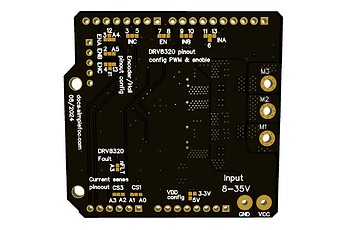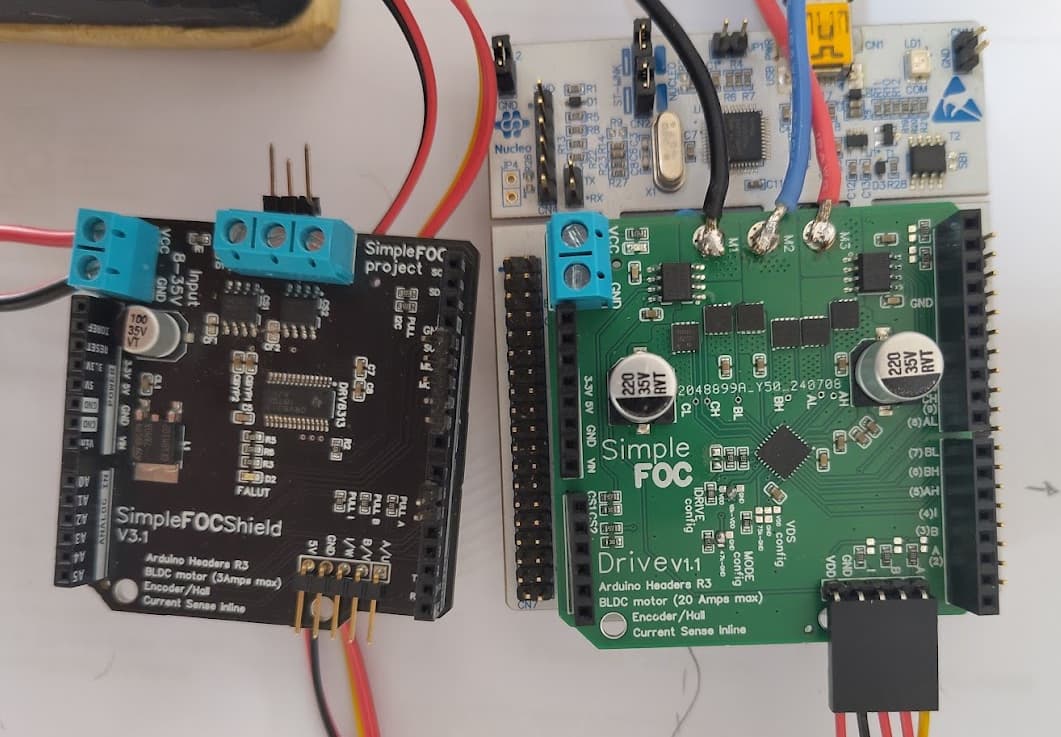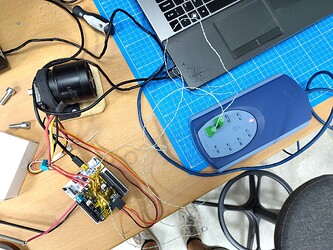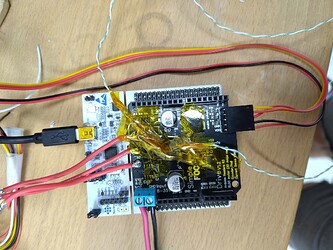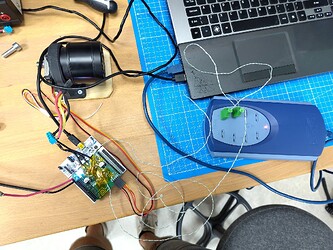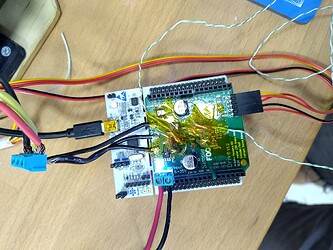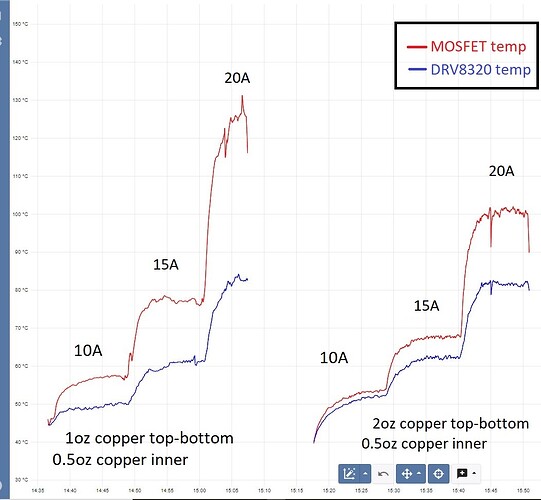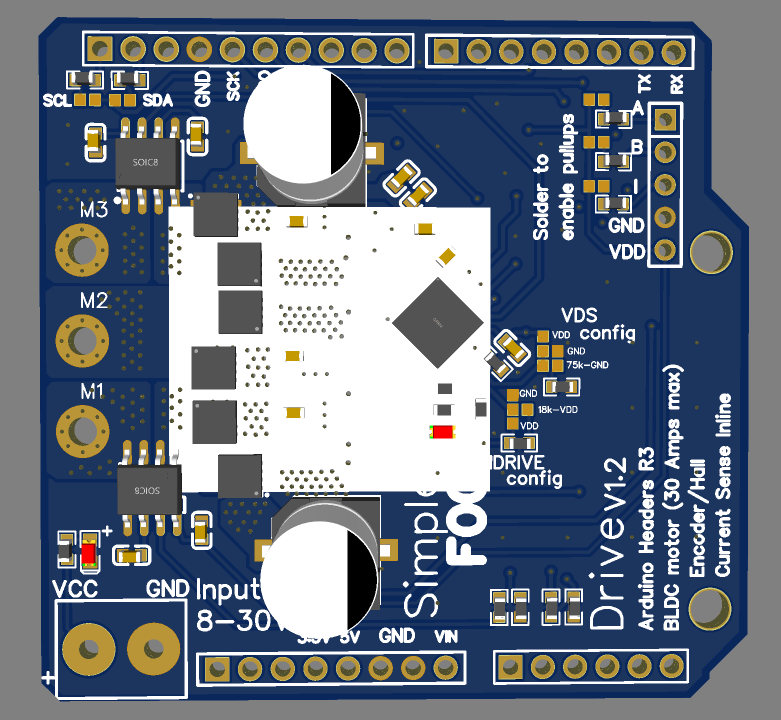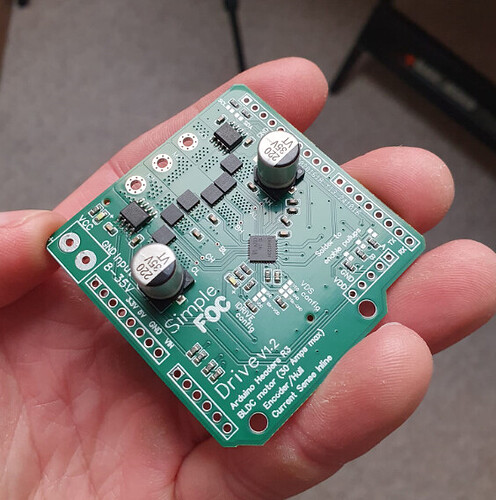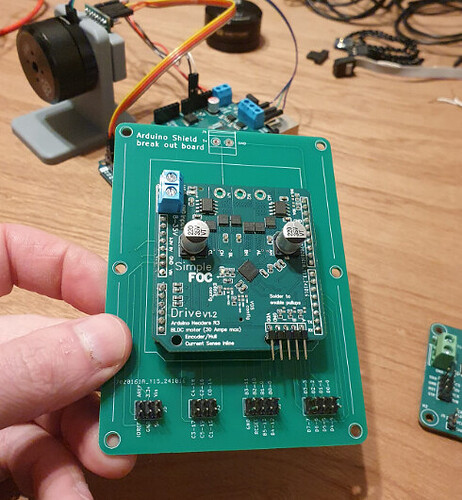Hi guys,
I’ve been following the footsteps of many of the community members especially Valentine and created my take on the more powerful SimpleFOCShield. I’m calling it SimpleFOC DriveShield. ![]()
The board is the big brother of the SimpleFOCShield and is designed to drive motors with higher current requirements, up to 30Amps. The board is created with the same philosophy as the SimpleFOCShield - to be simple to use, low-cost, and completely open-source.
Additionally the aim of the board is to serve as a template project for the community to build their own motor drivers.
- The board is relatively simple and can be easily modified to fit different requirements
- change the mosfets
- change the gate driver
- The board is designed in EasyEDA and it’s easy to manufacture with JLCPCB
Components
- DRV8320H gate driver
- Hardware configuation
- 3PWM
- Protections: undervoltage lockout, charge pump fault, MOSFET overcurrent, MOSFET short circuit, gate driver fault and overtemperature
- BSZ0904NSI mosfets
- Standard 3mm x 3mm footprint (can be easily exchanged)
- Max current: 75A
- Max voltage: 30V
- Max temp: 150C
- ACS712:
- 30Amps bidirectional
- In-line current sensing
Features
- Boards absolute max ratings
- Max current: 20A continuous (peak 30A - measured),
- Max input voltage: 30V
- Stackable: running 2 motors in the same time
- Encoder/Hall sensors interface: Integrated 3.3kΩ pullups (configurable)
- I2C interface: Integrated 4.7kΩ pullups (configurable)
- Configurable pinout: Hardware configuration - soldering connections
- Arduino headers: Arduino UNO, Arduino MEGA, STM32 Nucleo boards…
- Open Source:
- Fully designed in EasyEDA: EasyEDA project
- Available on github too: github repo
- Low-cost (relatively): Estimated price of 25-40€ - Will be available in the SimpleFOC shop
Size comparison with SimpleFOCShield v3
Temperature characteristics
This board can measure the phase currents up to 30Amps, so it is intended to be used in applications that require current draw up to around 20Amps continuous. For higher currents especially in the range of 15-30Amps the board can get quite hot. Depending on the copper thickness of the PCB chosen when ordering the board the temperature can vary. Also, the board could be fitted with a heatsink to improve the thermal discipation.
So I’ve wanted to quantify the temperature characteristics of the board when a continuous current is applied to the motor. The measurements were done with a relatively constant ambient temperature of around 25°C. The board was powered with 24V. The motor was run at very low speed (0.1rad/s) in the open loop and the current (q component) was set to 10, 15 and 20 amps for prolonged periods of time. I’ve measured the temperature on the top of the board on the DRV8320H gate driver and the BSZ0904NSI mosfets. I’ve used the PICOLOG TC-08 thermocouple data logger to do the measuring.
I’ve tested the same board with two different copper layer thicknesses
- Standard 4-layer:
- 1oz (35um) copper thickness on top and bottom layers,
- 0.5oz (17.5um) copper thickness on inner layers
- Thick 4-layer:
- 2oz (70um) copper thickness on top and bottom layers,
- 0.5oz (35um) copper thickness on inner layers
Standard 4-layer PCB (1oz top and bottom, 0.5oz inner layers)
Thick 4-layer PCB (2oz top and bottom, 0.5oz inner layers)
Experiment results
Here is the table of the results
| Current [A] | Standard 4-layer MOSFETS | Thick 4-layer MOSFETS | Standard 4-layer DRV8320 | Thick 4-layer DRV8320 |
|---|---|---|---|---|
| 10 | 57°C | 53°C | 50°C | 52°C |
| 15 | 78°C | 68°C | 62°C | 62°C |
| 20 | 125°C | 100°C | 82°C | 82°C |
And here is the curve from the experiment:
So the results seem to suggest that, as the BSZ0904NSI mosfets are rated for temperatures up to 150°C and the DRV8320H gate driver up to 125°C, the board can be used up to 20Amps without additional cooling.
However, I would definitely recommend using a heatsink or a thicker copper PCB (2oz top and bottom layers) for currents above 15Amps continuous.
So there it is guys. Even though this is the first real iteration of this board and I’m sure there will be many more in the future, I am pretty happy with this board for now ![]()
The board will be available in the shop at some point in the future, I am not really sure when though, not before November.
I’d be very happy to hear your comments about it!
Cheers,
Antun
EDITED: I’ve forgotten that I’ve tested up to 20Amps not to 30Amps continuous as in my original post!

